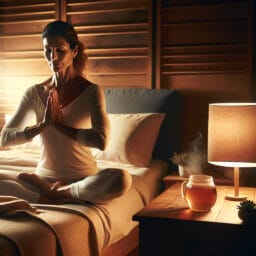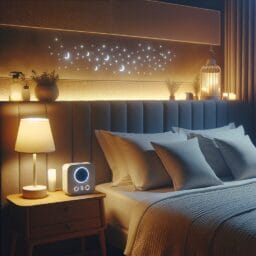
Top Tips for Creating a Sleep-Friendly Bedroom Environment
Table of Contents
- Introduction
- The Science Behind a Sleep-Friendly Bedroom Environment
- Top Tips for Creating a Sleep-Friendly Bedroom Environment
- Additional Tips
- Conclusion
- References
- Frequently Asked Questions
Introduction
The essential role of good sleep in maintaining overall health and wellbeing can’t be overstated. In this digital age, where our attention is constantly pulled towards electronic devices emitting bright light, creating a sleep-friendly environment has become more important than ever. Imagine an oasis of calm and tranquility; your bedroom is not just a place to fall asleep but rather a sanctuary designed for sleep quality. One key element is the right mattress and pillows – may it be memory foam or hybrid mattress, it should provide ample support and temperature regulation for your body to relax fully. Another critical aspect is controlling the bedroom environment’s darkness and quietness; blackout curtains block out disruptive lights, while a white noise machine can mask background sounds.
However, getting good sleep doesn’t stop at curating physical conditions; it also involves adhering to a regular sleep schedule as part of practicing optimal sleep hygiene. This trains your circadian rhythm – body’s internal clock – aligning it with day-night cycles thus making bedtime predictable and restful.
Just as colors affect our mood during daytime activities, so do they influence us at night. Cool tones like blues or greens on walls or decor can contribute to creating a more serene ambience conducive for sleeping while keeping the bedroom tidy reduces stress levels by eliminating visual clutter.
Despite changes made in the physical environment, personal habits also significantly impact how well you fall asleep. It’s wise to limit caffeine intake and avoid heavy meals close to bed time since they make falling asleep difficult due their stimulating nature. Similarly limiting exposure to electronic devices before bedtime helps reduce blue light that tends to interfere with natural onset of sleep.
Moreover investing in cooling mattresses or breathable sheets empowers temperature control which enhances comfort leading you into deeper stages of slumber improving overall quality of sleep.
Remember – what works best differs from person-to-person experiment with different strategies complemented by exercise & balanced diet for achieving that perfect snooze!
The Science Behind a Sleep-Friendly Bedroom Environment
Many might not realize it, but the environment of your bedroom significantly shapes the quality of sleep you get each night. Scientific studies have shown a strong correlation between a sleep-friendly environment and improved sleep quality, which in turn has a profound impact on mental health. A well-structured bedroom environment is like an orchestra playing in harmony to lull you into a peaceful slumber. It begins with the right mattress and pillows – whether you prefer memory foam or hybrid mattress, they should offer adequate support while ensuring temperature regulation for ultimate relaxation.
A key aspect of this symphony is maintaining darkness and quiet within your sanctuary. Using blackout curtains can effectively obstruct any bright light from infiltrating your room; these are particularly beneficial for urban dwellers dealing with city lights or early sunrise. Complementing this, white noise machines are instrumental in drowning out any ambient sounds that could disrupt your restful slumber.
However, setting up physical conditions is not enough; incorporating best practices of sleep hygiene plays an equally critical role in enhancing sleep quality. A regular sleep schedule aligns with your circadian rhythm – body’s internal clock – making bedtime more predictable and restful.
The colors and decor used within your room also play their part in creating a tranquil atmosphere conducive to better rest at night. Decorations using cool tones like blues or greens evoke soothing vibes helping you fall asleep quicker while maintaining an organized ‘bedroom tidy’ reduces stress levels by eliminating visual clutter.
In this digital age where we’re glued to our electronic devices, limiting electronics especially before bedtime becomes pivotal as exposure to blue light interferes with the natural onset of sleep. Likewise, moderating stimulants such as caffeine and alcohol close to bed time helps ensure uninterrupted rest as they tend to keep your nervous system alert making falling asleep difficult.
Lastly but critically important aspect revolves around temperature control; investing in cooling mattresses or breathable sheets promotes comfort by regulating body temperature leading into deeper stages of slumber thus improving overall sleep quality. Infusing essential oils like lavender into your sleep environment further enhances calmness and relaxation which can contribute to better rest.
While it may seem a daunting task to incorporate all these elements, they collectively contribute towards creating a nurturing environment that fosters good sleep. Remember, everyone is unique; experiment with different strategies complemented by regular exercise & balanced diet until you find what works best for you in achieving quality sleep. This will not only help you feel more refreshed in the morning but also positively impact your mental health in the long run.
| Elements of a Sleep-Friendly Bedroom | Explanation |
|---|---|
| Right Mattress and Pillows | Memory foam or hybrid mattress offering adequate support and temperature regulation for ultimate relaxation. |
| Darkness and Quiet | Maintained using blackout curtains and white noise machines to obstruct light and drown out disruptive sounds. |
| Sleep Hygiene | Incorporation of best practices like a regular sleep schedule aligning with circadian rhythm. |
| Room Decor | Use of cool tones and organized decor to create a tranquil atmosphere and reduce stress. |
| Limit Electronics | Reducing exposure to blue light from electronic devices, especially before bedtime. |
| Moderate Stimulants | Limiting intake of stimulants like caffeine and alcohol close to bed time. |
| Temperature Control | Investing in cooling mattresses or breathable sheets to regulate body temperature. |
| Essential Oils | Infusing oils like lavender to enhance calmness and relaxation. |
| Balanced Diet and Regular Exercise | Complementing a sleep-friendly environment with regular exercise and a balanced diet. |
Top Tips for Creating a Sleep-Friendly Bedroom Environment
Did you know that the quality of your sleep can be greatly influenced by the comfort level of your mattress and pillows? Choosing the right ones is therefore crucial in creating a sleep-friendly bedroom environment. Memory foam mattresses, with their body contouring feature, can help distribute weight evenly and relieve pressure points while sleeping. Hybrid mattresses, on the other hand, offer a balanced blend of support and comfort that combines innerspring’s bounciness with memory foam’s conformity. The correct pillow complements this setup by supporting your neck and head properly to prevent muscle strains or stiffness upon waking up.
Next comes darkness and quiet – these are not mere luxuries; they’re scientifically proven necessities for good sleep. Blackout curtains play an essential role here as they effectively block out intrusive bright light from street lamps or early morning sunlight that can disrupt your slumber. To combat noise disturbances from traffic or loud neighbors, consider using a white noise machine. This little gadget generates soothing sounds like rainfall or soft music that masks disruptive noises ensuring uninterrupted rest.
Temperature control is another pivotal factor to consider within your sleep environment. Overheating during slumber can not only disturb your rest but also impede the process of falling asleep initially. Hence it’s important to invest in breathable sheets and cooling mattresses which promote airflow thus regulating temperature leading into comfortable sleep.
Your choice of colors and decor could surprisingly influence how quickly you fall asleep too! Studies suggest cool tones such as blues or greens aid relaxation more than warmer hues do – making them ideal choices for bedroom walls or decor pieces like bedspreads or rugs. Keeping things tidy also contributes towards promoting calmness because clutter-free surroundings reduce stress levels generated through visual chaos.
Despite having all physical conditions aligned for optimal rest, you might still find it tricky to fall asleep if electronic devices are overused close to bedtime – particularly those emitting blue light such as smartphones & laptops which interfere with our circadian rhythm hindering natural onset of sleep. It’s wise to instill a habit of switching off these devices at least an hour before hitting the sack.
In addition to all these, limiting stimulants like caffeine and alcohol closer to bedtime can help avoid unnecessary alertness that delays sleep onset. Following a regular sleep schedule aids in setting your body’s internal clock syncing it with day-night cycles thus making bedtime more predictable and restful.
Alongside curating a conducive sleep environment, incorporating exercise into your daily regimen and following balanced diet can further boost your chances of achieving better quality sleep due its positive impact on both physical health as well as mental wellbeing.
Remember that while creating this sanctuary for peaceful slumber might require some effort, each tiny step contributes towards enhancing your overall quality of life by improving not only the quantity but also quality of rest you receive each night!
| Factors | Details | Suggestions |
|---|---|---|
| Comfort | Comfort level of your mattress and pillows can greatly influence your sleep quality. | Consider memory foam mattresses and the correct pillow to support your neck and head properly. |
| Darkness and Quiet | Scientifically proven necessities for good sleep. | Use blackout curtains and a white noise machine to block out light and noise disruptions. |
| Temperature Control | Regulating temperature is necessary to ensure comfortable sleep. | Invest in breathable sheets and cooling mattresses which promote airflow. |
| Decor and Colors | Your choice of colors and decor could influence your sleep onset. | Choose cool tones such as blues or greens, and keep your surroundings tidy to reduce stress. |
| Electronic Devices | Blue light from electronic devices can interfere with your sleep. | Switch off these devices at least an hour before bedtime. |
| Stimulants | Caffeine and alcohol can cause unnecessary alertness that delays sleep onset. | Limit your intake of these stimulants closer to bedtime. |
| Sleep Schedule | A regular sleep schedule aids in setting your body’s internal clock. | Follow a consistent sleep schedule to make bedtime more predictable and restful. |
| Exercise and Diet | Incorporating exercise into your daily regimen and following a balanced diet can boost your sleep quality. | Ensure regular exercise and a balanced diet for better physical health and mental wellbeing. |
Additional Tips
Surprising as it may be, your dietary habits and exercise regimen can significantly impact the quality of sleep achieved each night. Committing to an active lifestyle not only boosts physical health but also enhances mental wellbeing. Regular physical activity releases endorphins – natural mood lifters that can keep away stress and depression, common culprits known to disrupt good sleep. However, timing is key; exercising too close to bedtime might leave you feeling energized when you should be winding down for rest.
Pairing this with a balanced diet further amplifies positive results on sleep quality. Nutrient-dense foods like fruits, vegetables, lean proteins and whole grains fuel your body with essential vitamins and minerals promoting overall health including regular sleeping patterns.
While we’re on the subject of diet, it’s important to limit caffeine and alcohol intake closer to bedtime. Although an evening cap might seem relaxing initially, alcohol interferes with our circadian rhythm disrupting deep stages of sleep making us feel less rested upon waking up. Similarly caffeine consumption late in the day stimulates our nervous system delaying our body’s internal clock hindering us from naturally falling asleep at night.
The foundation for all this lies in maintaining a consistent sleep schedule as part of practicing optimal sleep hygiene which trains your body’s internal clock aligning it with day-night cycles thus making bedtime more predictable and restful.
Remember that weaving these factors into daily life doesn’t just translate into better nights; instead they collectively contribute towards creating a nurturing bedroom environment optimizing not just quantity but also quality of rest achieved each night paving the way for improved mental health in long run! So why wait? Take those first steps towards curating your own personal sanctuary conducive for peaceful slumber starting today!
Conclusion
Creating a sleep-friendly bedroom environment isn’t just about choosing the right mattress and pillows or designing an aesthetically pleasing space. It’s a comprehensive approach that incorporates temperature control, limited exposure to bright light and electronic devices, as well as maintaining darkness and quiet through blackout curtains or white noise machines. Strategic choices in colors and decor can set a serene ambience conducive for relaxation while keeping the bedroom tidy reduces stress by eliminating visual clutter. A regular sleep schedule is also vital in synchronizing our circadian rhythm with day-night cycles making bedtime more predictable and restful. Incorporating exercise into daily regimen along with balanced diet not only boosts physical health but also aids mental wellbeing thus enhancing overall quality of sleep achieved each night. Limiting caffeine and alcohol close to bed time further promotes good slumber since they tend to keep your nervous system alert disrupting natural onset of sleep. The essence lies in creating an oasis that caters not just to physical comfort but also addresses psychological factors influencing good sleep, ultimately paving way for improved mental health.
References
Integrating elements like the right mattress and pillows, optimal temperature control, and a neat decor in soothing colors can significantly enhance your sleep quality. Essential oils coupled with darkness and quiet, achievable via blackout curtains or a white noise machine, create an ideal environment promoting restful slumber. Building upon this foundation is the practice of maintaining regular sleep schedule which aligns with our internal body clock – circadian rhythm. Pairing this with limiting exposure to blue light from electronic devices before bedtime further aids natural onset of sleep. Alongside these measures investment in cooling mattresses or breathable sheets promotes temperature regulation leading to deeper stages of slumber thus improving overall quality of sleep. Also pivotal is the adherence to exercise regimen complemented by balanced diet which collectively contribute towards better mental health and wellbeing. Lastly but importantly it’s wise to limit consumption of stimulants like caffeine & alcohol closer to bed time as they tend to interfere with peaceful rest.



